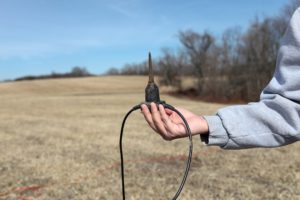All Categories
Featured
Table of Contents
Geophysical Surveys & Mapping - Ecs Limited in Kallaroo Western Australia 2023

(PREM)., and the boundaries between layers of the mantle are consistent with phase shifts.

Schematic of Earth's magnetosphere. Circulations from left to.
Inside the magnetosphere, there are relatively dense areas of solar wind particles called the Van Allen radiation belts. Geophysical measurements are typically at a particular time and place.
Geophysical Methods in Carmel Western Australia 2020
, integrates astronomical collaborates and the regional gravity vector to get geodetic coordinates. This approach just supplies the position in two coordinates and is more difficult to use than GPS.
Gravity measurements became part of geodesy because they were required to associated measurements at the surface area of the Earth to the reference coordinate system.
Sea level can also be determined by satellites utilizing radar altimetry, adding to a more accurate geoid. In 2002, NASA launched the Gravity Recovery and Environment Experiment (GRACE), where two twin satellites map variations in Earth's gravity field by making measurements of the range in between the two satellites utilizing GPS and a microwave ranging system. , which are studied through geophysics and area physics.
Careers In Geology And Geophysics in Willagee Aus 2021

Considering that geophysics is interested in the shape of the Earth, and by extension the mapping of features around and in the planet, geophysical measurements include high accuracy GPS measurements. These measurements are processed to increase their precision through differential GPS processing. When the geophysical measurements have been processed and inverted, the analyzed outcomes are outlined using GIS.
Many geophysics companies have developed in-house geophysics programs that pre-date Arc, GIS and Geo, Soft in order to satisfy the visualization requirements of a geophysical dataset. Expedition geophysics is applied geophysics that often uses remote sensing platforms such as; satellites, airplane, ships, boats, rovers, drones, borehole noticing devices, and seismic receivers.
For example, aeromagnetic data (airplane collected magnetic data) collected using standard fixed-wing airplane platforms need to be remedied for electromagnetic eddy currents that are produced as the aircraft moves through Earth's electromagnetic field. There are also corrections connected to modifications in determined prospective field intensity as the Earth turns, as the Earth orbits the Sun, and as the moon orbits the Earth.
An Assessment Of Geophysical Survey Techniques ... in Bullsbrook Aus 2022
Signal processing includes the correction of time-series data for undesirable noise or errors presented by the measurement platform, such as aircraft vibrations in gravity data. It likewise involves the reduction of sources of noise, such as diurnal corrections in magnetic information. In seismic data, electro-magnetic information, and gravity information, processing continues after error corrections to include computational geophysics which lead to the last interpretation of the geophysical data into a geological analysis of the geophysical measurements Geophysics emerged as a separate discipline only in the 19th century, from the crossway of physical geography, geology, astronomy, meteorology, and physics.
The magnetic compass existed in China back as far as the 4th century BC. It was not up until great steel needles could be created that compasses were used for navigation at sea; before that, they could not keep their magnetism long enough to be helpful.
By looking at which of eight toads had the ball, one could figure out the direction of the earthquake. It was 1571 years before the first style for a seismoscope was published in Europe, by Jean de la Hautefeuille. It was never developed. One of the publications that marked the beginning of modern science was William Gilbert's (1600 ), a report of a series of meticulous experiments in magnetism.
Geophysical Survey Services in Myaree Western Australia 2022
In 1687 Isaac Newton published his, which not just laid the structures for classical mechanics and gravitation but also described a variety of geophysical phenomena such as the tides and the precession of the equinox. The first seismometer, an instrument efficient in keeping a constant record of seismic activity, was constructed by James Forbes in 1844. Geochemistry, Geophysics, Geosystems. National Aeronautics and Space Administration. Recovered 13 November 2018.
Runcorn, S.K, (editor-in-chief), 1967, International dictionary of geophysics:. Pergamon, Oxford, 2 volumes, 1,728 pp., 730 fig Geophysics, 1970, Encyclopaedia Britannica, Vol. Introduction to seismology (Second ed.).
Table of Contents
Latest Posts
What Are Geophysical Surveys & Why Do They Matter in Parkwood WA 2023
Geophysical Methods in Merriwa Western Australia 2021
Geophysicist: Job Description, Duties And Requirements in Western Australia 2022
More
Latest Posts
What Are Geophysical Surveys & Why Do They Matter in Parkwood WA 2023
Geophysical Methods in Merriwa Western Australia 2021
Geophysicist: Job Description, Duties And Requirements in Western Australia 2022